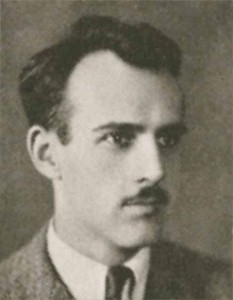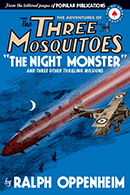Frederick Blakeslee
 Frederick Manley Blakeslee was born in Buffalo, New York on December 4, 1898. Buffalo was a massive rail center with over thirty different lines moving rail passengers and freight throughout the country. It was also the head end of the Erie Canal. The canal begins in Buffalo and carries ships eastward to connect with the Hudson River near Albany, and then south to New York. These forces of commerce combined to make Buffalo a dynamic factory town of historic proportions at the time of Blakeslee’s childhood.
Frederick Manley Blakeslee was born in Buffalo, New York on December 4, 1898. Buffalo was a massive rail center with over thirty different lines moving rail passengers and freight throughout the country. It was also the head end of the Erie Canal. The canal begins in Buffalo and carries ships eastward to connect with the Hudson River near Albany, and then south to New York. These forces of commerce combined to make Buffalo a dynamic factory town of historic proportions at the time of Blakeslee’s childhood.
In June of 1911, during the Buffalo Aviation Meet, a pilot took off from the Buffalo Driving Park for a sensational stunt flight over Niagara Falls. The park was a short walk from the Blakeslee home. It is easy to imagine 12 year old Fred Blakeslee among the twenty-thousand spectators gathered to witness the world’s first crossing of Niagara Falls in an aeroplane.
In 1916 Glenn Hammond Curtiss opened the world’s largest aeroplane factory on a thirty-one acre industrial complex in Buffalo. The Curtiss Aeroplane Company employed 18,000 workers. Among those new employees was the seventeen-year-old Fred Blakeslee, who was an office boy in the design department where Curtiss himself worked at a drafting table. He was soon promoted to assistant-draftsman where he was also able to inspect the construction of sample aircraft from Germany, Italy, Britain, and France. The opportunity to work in the pioneer years with some of the founders of aviation design was a profoundly formative experience.
During these years, Blakeslee studied drafting, lettering, drawing, and design in night classes at the Albright Art School. They taught Blakeslee color theory, design, and composition. Although he was a good student, his main interest in art school was to improve his drafting skills for a career in aviation design.
The first day that Frederick Blakeslee was eligible for the mandatory National draft registration was on September 12, 1918. He reported to his local board for registration and a physical exam and he was accepted for induction in the Army. As fate would have it, the war ended just two months later and the young draftsman was never mobilized
In 1920, Curtiss moved his Buffalo design department to a Long Island testing-grounds in Amityville, NY. He created the Curtiss-Sperry Company in 1920, with a design team that happened to include the twenty-one-year-old Frederick Blakeslee. Fred was excited to be a part of the project, and to move away from home to an apartment in Brooklyn,
While working at the Curtiss-Sperry Company, Blakeslee discovered that several senior draftsmen had received professional certification from the nearby Pratt Institute. Although certification was not a college degree, it did qualify the recipient to work at the highest industrial standards. Most students held full-time jobs and could only supplement their skills by enrolling in night-school open course work. By 1924 Blakeslee was working part-time for Sperry Gyroscope, so he decided to concentrate on earning his certification as a professional draftsman. He signed up for the certificate program, which was administered by the School of Drawing, Painting, and Illustration.
While a student at Pratt, Blakeslee faithfully continued his family tradition of attending Episcopal Sunday services. Saint Mary’s Church is across the street from the school, and there Fred met the rector, Reverend Doctor James Clarence Jones, a distinguished sixty five year-old clergyman, whose authoritative sermons profoundly impressed Blakeslee, almost as much as his pretty twenty year-old daughter, Lorna Covert Jones. Lorna had graduated from Packer College in Brooklyn and was studying Library and Archival Sciences at Pratt in order to qualify for work as a certified librarian. Lorna’s parents approved of Fred, so he was soon invited to family meals in the church rectory, where the couple began their formal courtship.
In 1926, Blakeslee earned his degree from Pratt to become a professionally certified draftsman, letterer, and commercial artist, after crossing paths with several other outstanding students—Walter Martin Baumhofer, Rudolph Belarski, Eugene M. Frandzen, John Fleming Gould, and Arthur Leslie Ross—all of who remained lifelong friends.
Blakeslee and Belarski were both hired as art teachers on the staff at Pratt Institute. Blakeslee taught classes in Lettering and Advanced Design.
By 1927 Blakeslee was supplementing his teacher’s income with small freelance jobs, doing pen and ink graphic design work for several New York publishers. He got his first big freelance assignment to design a book jacket for “To Kiss the Crocodile” (Harper & Brothers Publishers of London and New York).
During these years Blakeslee’s pen and ink story illustrations began to appear on the inside pages of pulp adventure magazines, and on September 26, 1929 his name first appeared on a pulp cover painting for War Stories.
In 1930, Fred and Lorna were married. Up until this time, Blakeslee had considered himself a technical draftsman, or a design teacher who dabbled in freelance work, but this marked the beginning of his professional career as an illustrator.
Soon he was creating cover art for most of the aviation pulp titles: Battle Aces, Battle Birds, Dare-Devil Aces, Fighting Aces, Flyers, G-8 And His Battle Aces, Submarine Stories, War Aces, and War Birds. He was widely considered among the best of his peers — Frank Tinsley, Rudolph Belarski, George Gross, James B. Settles, Charles Dameron, Eugene M. Frandzen, and the brothers August & Alex Schomburg. In addition to his paintings for cover assignments, Blakeslee drew over one thousand black and white interior story illustrations. He also created novel cartoon features such as Would You Believe It! and Did You Know, which he wrote under the alias “Larry Jones.”
By 1934 the artist had developed his closest business relationship with the pulp publisher Harry Steeger at Popular Publications.
In 1943 Popular Publications bought Railroad Magazine, and Blakeslee was able to fulfill another youthful inspiration. Ever since his Buffalo childhood, the artist had been fascinated by steam locomotives, and these new cover assignments finally allowed his vision of the iron horse to move out from the backgrounds of his aviation covers and steam full-throttle into the center stage of his fifty-one cover paintings for Railroad Magazine. While Blakeslee had plenty of assignments to paint railroad covers, Popular Publications sent the last issue of an aviation pulp to the newsstands in November 1946, marking the end of Blakeslee’s career in pulp aviation.
The June 1951 issue of Railroad Magazine was the last pulp published with a Blakeslee cover. Harry Steeger followed the public, whose reading habits were moving away from the pulps and toward the men’s adventure magazines, of which Argosy became his best seller. Blakeslee received occasional assignments for that magazine, but he was no longer able to depend on a steady income from Popular Publications. Through his connections with other artists, Blakeslee received a few freelance assignments for American Weekly Magazine. Although these jobs paid better than the pulps, there were only sporadic assignments and Blakeslee needed more income.
John Fleming Gould was a friend and neighbor, as well as an old classmate from Pratt. After his own distinguished career as a pulp illustrator, Gould had found steady work creating designs for a Long Island ceramics manufacturer, Delano Studios. Delano asked Gould to paint some images for a series of decorative plates to commemorate the early history of the railroad in the vintage Americana style of Currier & Ives. Gould kindly suggested Delano hire Blakeslee as a specialist in railroad art. Fred was grateful for the opportunity and was soon regularly producing freelance assignments for Delano Studios. These were simple low-paying jobs, but it was easy work because Delano Studios was close to Fred’s Long Island home. The Blakeslee’s still needed more income.
In 1949 he offered his drafting services to his old friends in the design department at Sperry Gyroscope. The company had since outgrown their Brooklyn plant and moved into a gigantic new facility on Long Island built for them by the government during WWII. His remaining years of employment were spent at a drafting table under fluorescent lighting in the enormous military-industrial complex in Lake Success, which in 1955 was renamed the Sperry Rand Corporation.
When Fred was sixty-four he decided it was time to retire. The Blakeslee’s sold their Long Island home and moved to Danville, Vermont where they lived a modest life, attending the All Saints Episcopal Church in Littleton, New Hampshire, Fred was happy to contribute his design services to the church bulletins and pamphlets.
Blakeslee’s retirement years were spent in a relaxed country village, where he was free to drive around the White Mountain National Forest with his folding French easel and paint the traditional Americana landscapes that occupied his creative energies during the final decade of his life. On March 5th, 1973, Frederick Manley Blakeslee died of a heart attack at age 74.

(From David Saunders’ Blakeslee biography in The Red Falcon: The Dare-Devil Aces Years Volume 2, used here with the kind permission of Mr. Saunders)





